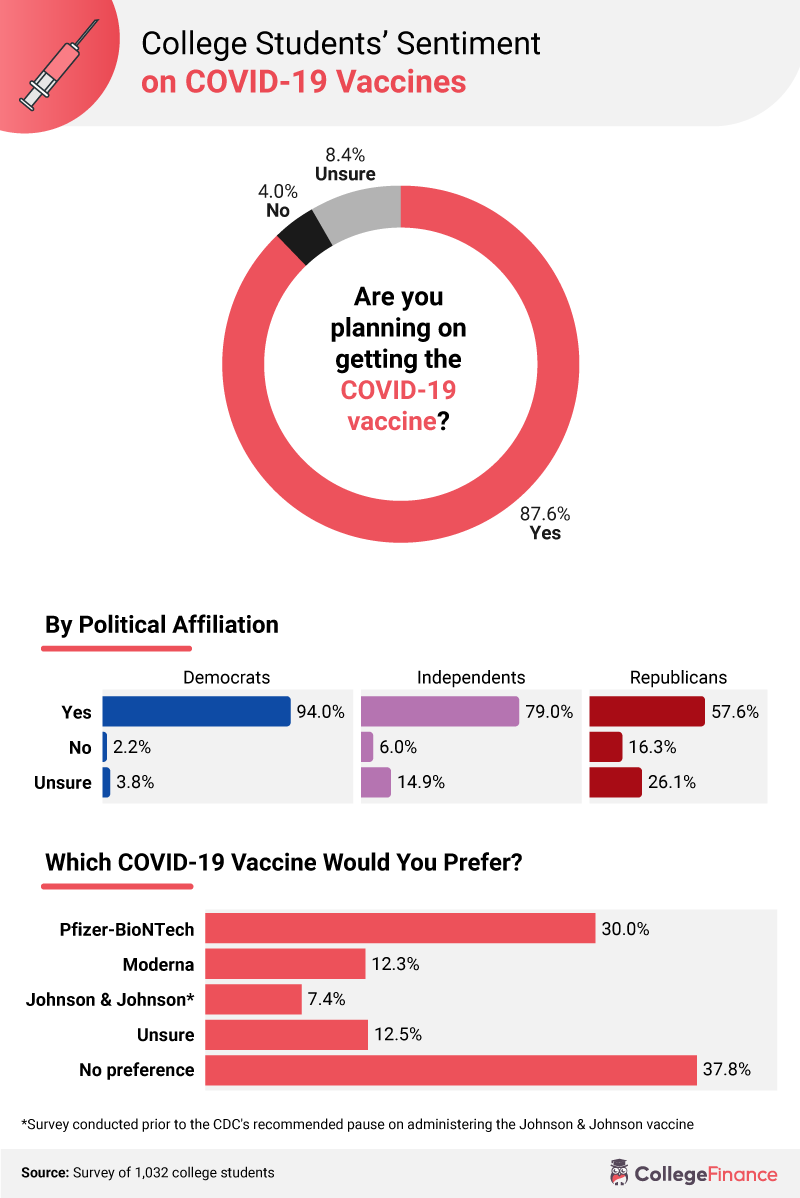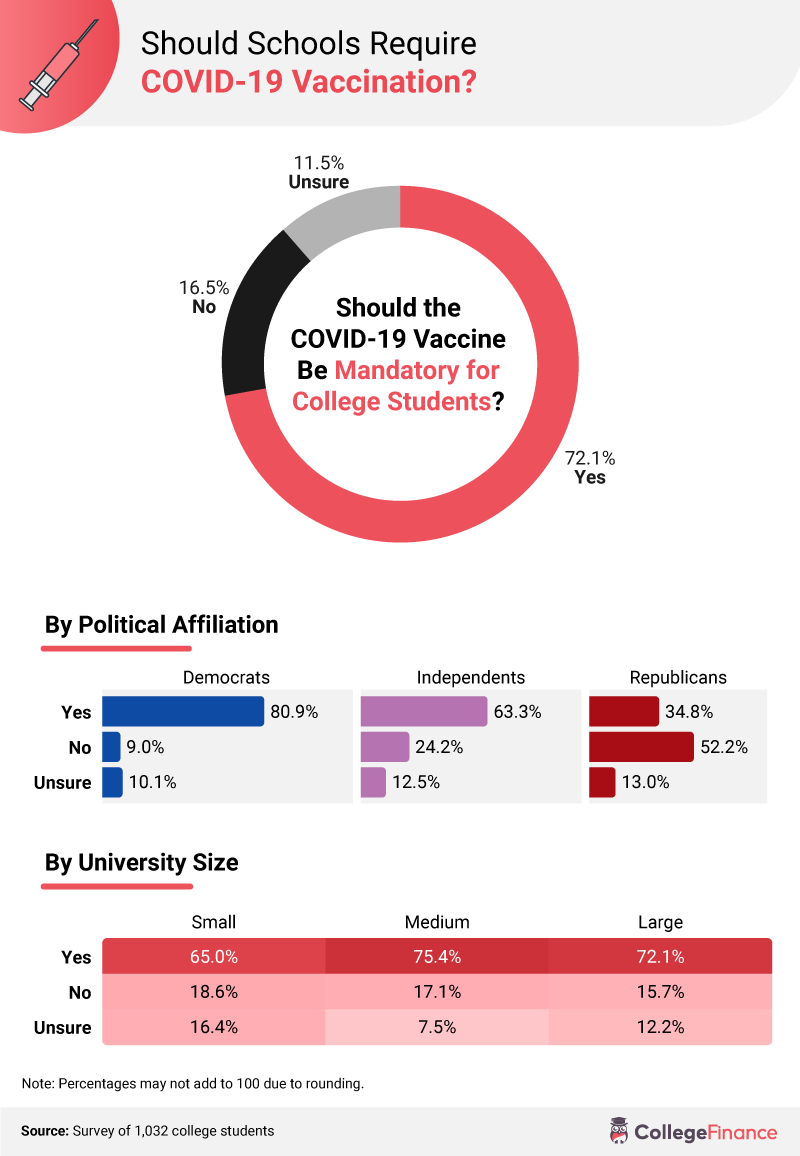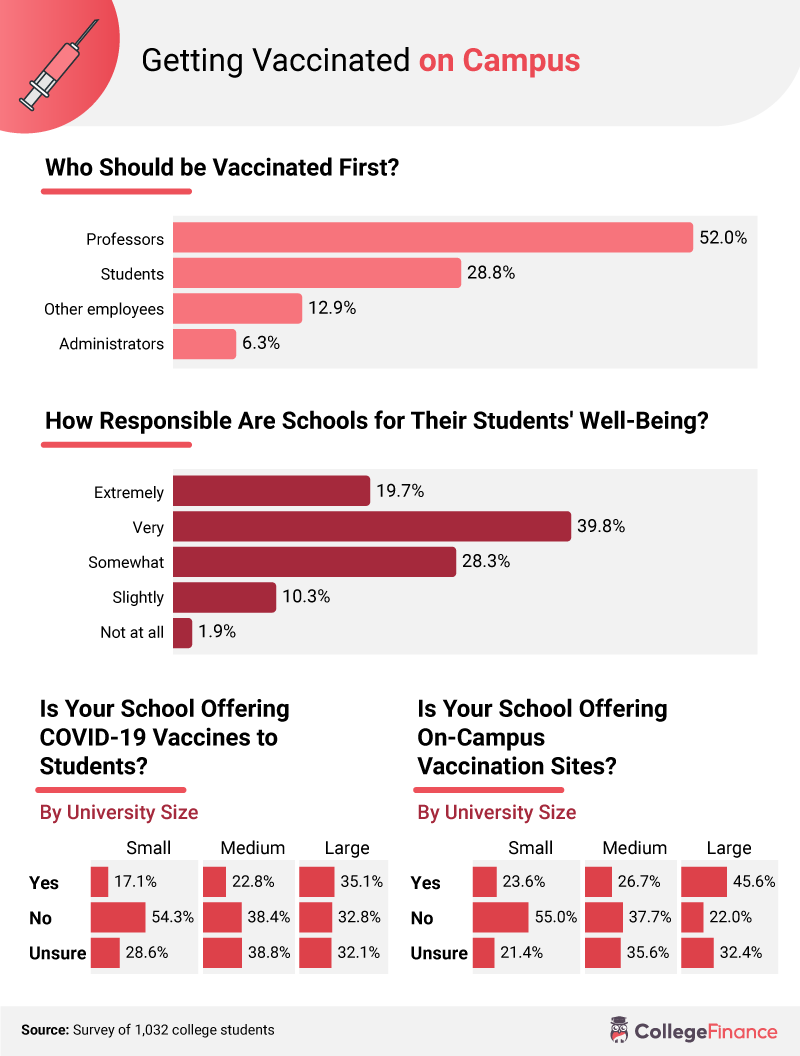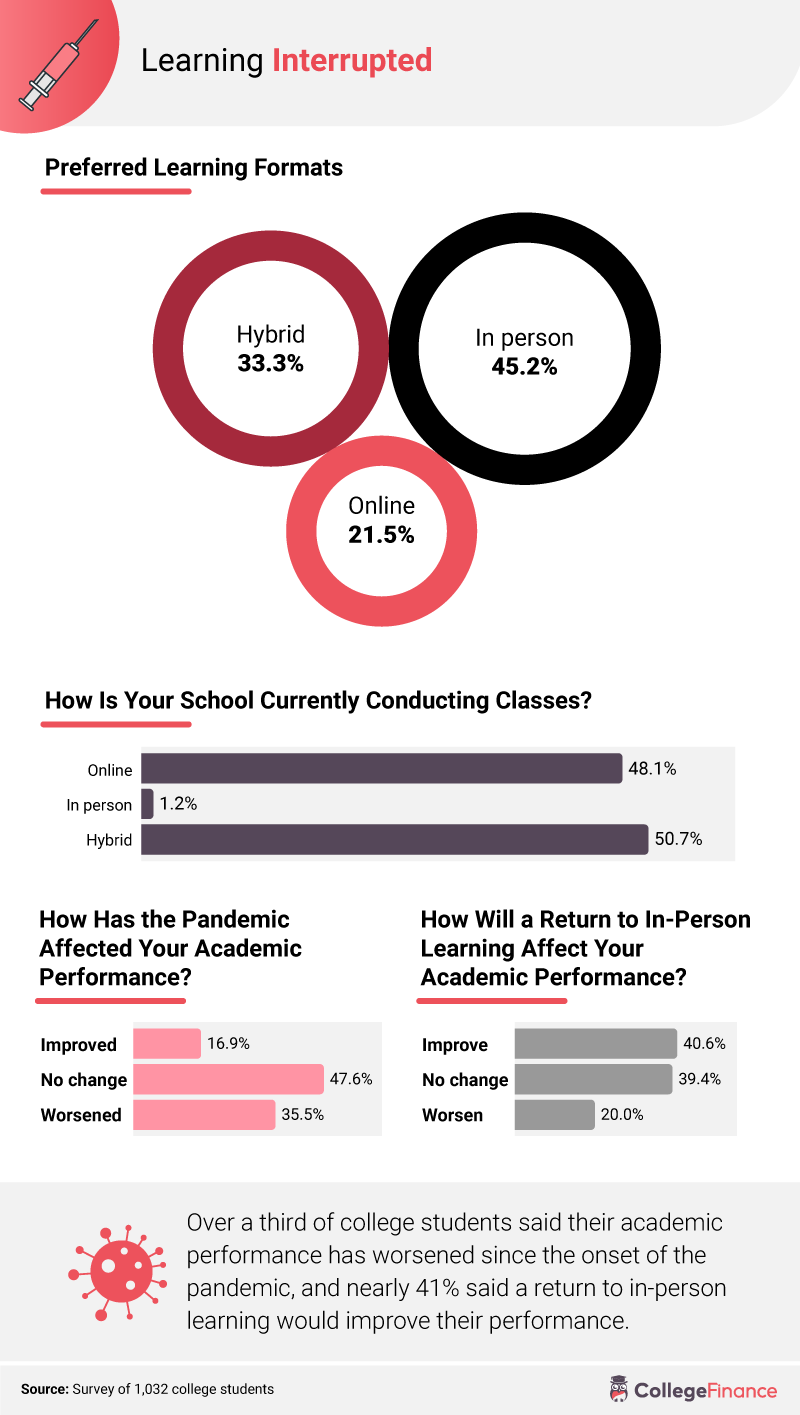Highlights:
- Nearly 88% of college students said they planned to get the COVID-19 vaccine as soon as they were able.
- Over 7 in 10 students said they think that the COVID-19 vaccine should be required for college students.
- Most students believed that campus life wouldn’t completely return to normal until Spring 2022.
The newest phase of the pandemic is upon us: vaccination. After over a year of the seemingly uncontrollable spread of the virus known as COVID-19, a glimmer of hope has appeared in the form of a sharp needle, a Band-Aid, and a 4-by-5 index card proving vaccination status. At the time of writing, over 36% of Americans had received their first dose and can now hold their vaccination record cards up high. That being said, not everyone agrees that vaccination is the answer we’ve been waiting for.
As vaccines roll out, vastly diverse and sometimes opposing opinions are being tossed back and forth in discussions across the country. While most can agree on the desire and need to get “back to normal,” not everyone can agree on exactly how to do so. The debate has leaked into the actions of U.S. colleges as they decide whether or not student vaccinations should be mandatory. We wanted to know how students felt about these important decisions being made on their behalf, so we surveyed 1,032 college students in the U.S. to find out. Read on to see college students’ sentiment toward COVID-19 vaccinations; the role they think their school should play; how the pandemic has affected their studies; and more.
To Vaccinate, or Not to Vaccinate
First things first, how many college students are actually planning on getting the vaccine? To find out, we asked them. Keep reading to see not only how many students are planning on vaccination but also how these numbers change based on political affiliation.

Now that states are opening vaccine eligibility to young people, many college students are able to take the important step of scheduling a vaccine shot. Our survey revealed nearly 9 in 10 will take the vaccine once it becomes available to them – with only 4% opting out. Among respondents, Pfizer came out as the most preferred vaccine, followed by Moderna.
Unsurprisingly, politics play a vital role in how people perceive vaccines. According CBS News, almost 1 in 3 Republicans “definitely won’t” get vaccinated. However, according to the survey, only 16.3% of Republican college students admitted they would refuse the vaccine, while roughly 58% said they plan on receiving it.
On the flip side, 94% of Democratic respondents said they would take the vaccine, with a minuscule 2.2% refusing. Independents fell in the middle of this debate with a slight lean toward the Democratic side of things: 8 in 10 affirmed they would get vaccinated.
General distrust toward vaccines stems from skepticism surrounding their creation, particularly due to the rapid rate at which the COVID-19 vaccines were developed. In fact, according to another survey, young people are more likely to distrust COVID-19 vaccines than older generations.
Despite this distrust, why do students prefer one vaccine over another? A significant amount of talk has centered on efficacy, with Pfizer taking the top spot and Moderna falling shortly behind. While Johnson & Johnson came in third with 7.4% of college students voicing preference for it, it’s important to note that this survey was conducted prior to the Centers for Disease Control and Prevention’s (CDC) recommendation to pause use of the vaccine while investigating some rare but serious side effects.
Students should read guidelines published by the CDC and local state health officials to understand their options regarding COVID-19 vaccinations fully.
Required or Optional?
While some students are still deciding how they feel about the vaccine, colleges are debating whether vaccination should be a requirement for returning to campus. The next part of our study explores this and how students’ answers to this question differ based on political affiliation and the size of their university.

Despite the overwhelming majority of our respondents planning on getting vaccinated, college students were more divided when asked if colleges should require the COVID-19 vaccine. According to our survey, a little over 7 in 10 believed it should be compulsory to get vaccinated.
As expected, Republicans and Democrats are split on this issue, with the majority of Republican respondents arguing against required COVID-19 vaccinations. This time, a larger portion of Democratic students also disagreed with introducing mandatory COVID-19 vaccinations.
Additionally, university size influenced students’ responses, with a greater percentage of respondents from medium and large universities voting for required vaccines than those from small universities. Intuitively, this makes sense given that larger campuses are more likely to be exposed to outbreaks.
If colleges choose to implement mandatory COVID-19 vaccinations, it would not be without precedent. In fact, colleges often require vaccinations that fight against diseases such as HPV, meningitis, and measles. As more and more people start to travel again, airlines are equally expected to mandate COVID-19 vaccinations. The discourse around whether institutions such as universities should require vaccines stems from general distrust toward their fast development. Ultimately, colleges and public institutions need to spend time and resources educating their populations on the collective benefits of receiving a COVID-19 vaccine.
After all, a vaccinated student body means a return to in-person courses, football games, indoor gatherings, parties, and more. Colleges should consider researching how to best reach this age group in order to safeguard their student populations’ health and well-being.
The School’s Role
Just how involved should schools be when it comes to students’ well-being? Our study received varying responses to this question and more.

Generally, respondents agreed that professors should receive vaccinations before other groups at the university, with roughly half of the students putting instructors over themselves. Yet, students still felt that they deserved priority over other on-campus employees, especially administrators.
Our college-attending respondents generally agreed that universities are responsible for the well-being of their students. Almost 9 in 10 students believed colleges are at least somewhat responsible, and nearly 20% of those respondents believed universities are extremely responsible for student welfare.
In the context of the COVID-19 pandemic, this means providing mental health resources and eventually helping students get vaccinated. According to our survey, smaller colleges were the least likely to offer vaccines and vaccination sites. Alternatively, larger universities were most likely to offer these services at about 35% and 46%, respectively.
More interestingly, a large percentage of students had no idea if their schools intended on offering vaccines. In fact, roughly a third of respondents in small, medium, and large universities did not know if they could get vaccinated through their institution. Ultimately, this means that universities need to be clearer in terms of how they can assist their students as vaccinations start becoming available to the younger generation.
Getting Back to Normal
The next opinion we wanted to hear from students was their take on the return to normalcy. Will campuses return fully to in-person instruction next semester, the semester after that, or maybe the one after that? Check out what students thought below.

Even with the aggressive vaccine rollout, no one can say for certain when things will return to the way they were before the pandemic. However, with Biden recently announcing that all U.S. adults will be eligible to receive the COVID-19 vaccine by April 19, students are cautiously optimistic.
According to Oliver Wyman’s COVID-19 Pandemic Navigator, the majority of states in the U.S. are expected to reach herd immunity by mid-to-late July. In this scenario, the virus becomes practically immobile, and the community – which will have developed collective resistance – is protected. Compared to where we were just several months ago, this projection shows extensive progress.
While students believe that life on campus will return to normal in due course, our survey shows that they are erring on the side of caution as to when that will be. Although roughly 70% of respondents were at least somewhat hopeful about a return to normal campus life by fall 2021, almost half of the students we surveyed believed campus life and events are more likely to return to pre-pandemic conditions in spring 2022.
These students’ responses echo the general sentiment in the U.S.: The majority of Americans believe it will be at least one year before we return to a sense of normalcy. As vaccine rollout continues to pick up the pace, perhaps college students will become more and more optimistic moving forward. Either way, colleges have a responsibility to ensure their campuses remain safe – even after the pandemic ends.
Impact of the Pandemic on College Education
In these unprecedented times, colleges have had to adapt quickly to provide students with the education they were promised before the pandemic. To find out just how effective these adaptations have been, we asked students to share what they thought worked and what didn’t.

In early 2020, the onset of the pandemic took the typical college experience away from millions of students. Suddenly, classes hosted in large and historic lecture halls took place via a small screen on a Zoom call. Confident professors had to grapple with unfamiliar software, often sacrificing critical learning time for technological issues.
According to our survey, roughly half of classes went remote, while the other half went hybrid with elements of in-person teaching. Unsurprisingly, colleges are slowly beginning to open up and are permitting in-person classes – none of which could have happened when the pandemic first started this past year.
Students were, at the very least, able to test out their preferred learning mediums. Despite the jarring transition to remote learning, around one-fifth of respondents actually preferred this form of instruction over both in-person and hybrid learning. The status quo still remained the most popular option, however, with nearly half of the students ranking in-person teaching above the alternatives.
Students have had to contend with unprecedented challenges all while studying for exams and writing papers. They have undergone an extremely important transitional period in their life while under the constant threat of COVID-19 – which often impacted their ability to perform well in school. Nearly 36% of respondents felt their performance worsened because of the pandemic, with only about 17% citing improvement.
A Way Forward Beyond COVID-19
College students have been through a lot this year. The pandemic completely upended the college lives they were used to, and it’s not surprising that changes to how their education was structured impacted their academic performance. However, the COVID-19 vaccines do offer hope, especially as a majority of college students said they planned to get inoculated as soon as they were able.
One thing students shouldn’t have to worry about as they continue to navigate these unprecedented times is how they’ll afford their education. At CollegeFinance.com, we have the resources and knowledge to help you plan for your future. Head to our site today to get started.
Methodology
We surveyed 1,032 current college students on their feelings about COVID-19 vaccines and how the pandemic has impacted their college experience. Respondents were 55% women, 41.2% men, and 3.5% nonbinary. One respondent was gender-nonconforming, one respondent was transgender, and one respondent chose not to disclose their gender. The average age of respondents was 20.7.
Some of the data presented look at responses by political affiliation. Sample sizes for the three main political affiliations were as follows:
- Democrats: 633
- Independents: 248
- Republicans: 92
All other respondents selected or wrote in other affiliations. They were excluded from the final visualization of these data due to low sample sizes.
Some of the data presented look at responses by school size. We defined the school sizes for respondents as follows:
- Small: Less than 5,000 students
- Medium: 5,000–15,000 students
- Large: More than 15,000 students
Limitations
The data we are presenting rely on self-report. There are many issues with self-reported data. These issues include, but are not limited to, the following: selective memory, telescoping, attribution, and exaggeration.
Fair Use Statement
The pandemic has no doubt been difficult on many. College students have faced unique struggles throughout. If someone you know would benefit from the information in this project, you may share for any noncommercial use. We ask that you link back here so the entire project and its methodology can be reviewed. This also gives credit to the hardworking contributors who make this work possible.

